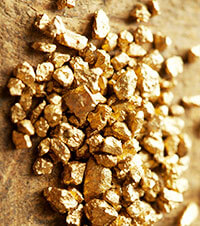Hard rock gold ore is a type of rock or mineral ore that contains gold and is typically sought after and mined for its gold content. These hard rock gold ores can exist in various forms, such as gold-bearing ore minerals, gold compounds, or gold particles. Hard rock gold is an important target in gold exploration and mining because it can serve as a sustainable source of gold.

The gravity separation process is a common physical beneficiation method that utilizes the differences in density of different minerals for separation. However, for different types of hard rock gold ores, specific gravity separation conditions and equipment may be required. Therefore, in-depth exploration and mineralogy analysis are needed to determine the appropriate beneficiation process.
Here are some general guidelines for hard rock gold ore and gravity separation:
Sulfide Gold Ores: Hard rock gold ores containing sulfides like pyrite, chalcopyrite, and sphalerite can often be beneficiated through a gravity separation process. Gravity separation can remove a portion of the sulfide minerals to increase the gold concentration. This process typically involves crushing, grinding, and then separation using gravity equipment such as centrifuges, spiral classifiers, shaking tables, etc.
Quartz Vein Gold Ores: Gold in quartz vein ores is usually embedded in quartz in the form of small or fine particles. Gravity separation can help in separating quartz from other minerals, thereby increasing the gold concentration. This involves processes like crushing, washing, and gravity separation.
Placer Gold Ores: Placer gold ores typically contain granular gold particles that can be separated by gravity separation. This can involve using gravity separation equipment such as shaker tables or sluice boxes.
Volcanic Rock Gold Ores: Volcanic rock gold ores often contain silicate minerals and other sulfides, so a gravity separation process may be applicable to remove the sulfide minerals. This can involve the use of gravity separation equipment and flotation processes.
Sometimes gravity separation processes are combined with other beneficiation methods such as flotation, magnetic separation, etc., to achieve better beneficiation results. This often requires determination through beneficiation tests.
The gravity separation process for hard rock gold ore typically involves several key steps. Here is an overview of a typical process:
Crushing and Grinding: The original ore is crushed and ground to refine the size of the particles and make gold particles more accessible for separation. This usually involves crushers and ball mills.
Washing: After grinding, the ore often contains a lot of fine particles and impurities. The washing process uses water to separate these impurities. This can help in removing clay, slimes, and fine-grained minerals.
Gravity Separation: This is the core step in the gravity separation process. Gravity separation equipment like jigs, centrifugal concentrators, shaking tables, and spiral classifiers are employed to separate gold from other minerals based on their density differences. Gold, being relatively dense, tends to be concentrated during this process.
Tailings Handling: The waste material generated during gravity separation typically includes sand, quartz, and other non-gold minerals. Proper disposal or management of these tailings is necessary to minimize environmental impact. Tailings disposal methods may include dewatering, settling ponds, or tailings stacking.
Product Handling: The product obtained after gravity separation often requires further processing to increase gold purity. This can include chemical leaching or smelting, among other subsequent steps.
Gravity separation of hard rock gold ore typically requires a range of equipment to achieve effective separation. Here are some common pieces of equipment used for gravity separation in hard rock gold ore processing:
Shaking Tables: Shaking tables use a shaking motion to separate particles based on their density differences. They are often used for fine and granular materials.
Centrifugal Concentrators: Centrifugal concentrators use centrifugal force to separate high-density particles, making them effective for separating gold.
Jigs: Jigs operate using pulsating water, which helps in stratifying particles based on their densities. They are commonly used in gold ore beneficiation.
Spiral Classifiers: Spiral classifiers separate particles based on size and density, and they are useful for separation in wet processing.
Dewatering Screens: Dewatering screens are used to remove water from processed materials, which can be beneficial for dewatering tailings and achieving dry stacking.
Cone Crushers and Ball Mills: These are used for crushing and grinding the ore before it undergoes gravity separation.
These pieces of equipment may vary depending on the specific characteristics of the ore, particle size, ore composition, and beneficiation requirements. When implementing a gravity separation process for hard rock gold ore, the selection of appropriate equipment or a combination of equipment is typically determined based on the actual circumstances. Additionally, optimizing the gravity separation process often requires the guidance of experienced engineers and geologists.